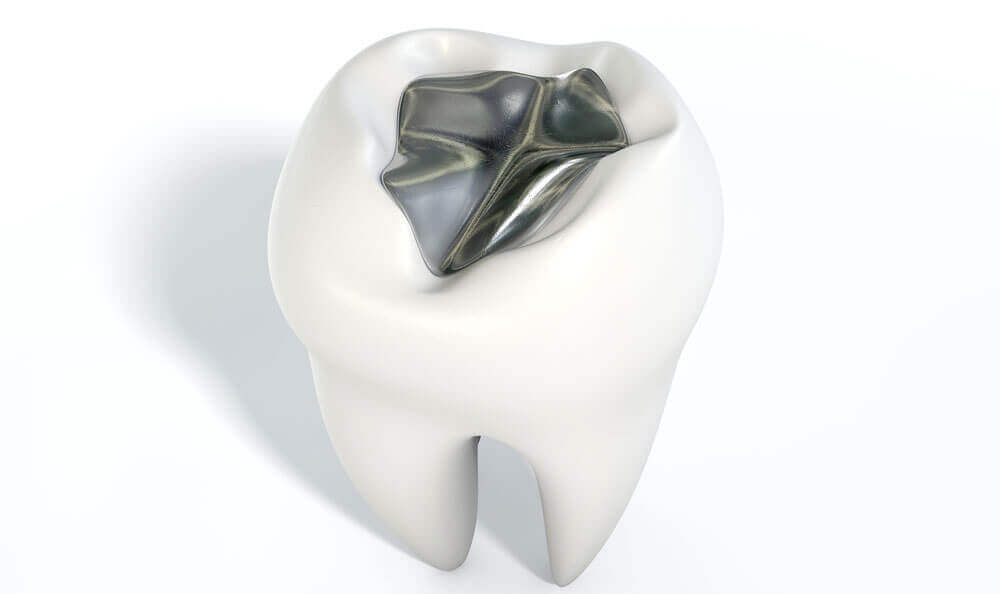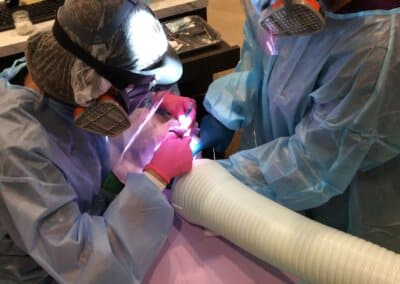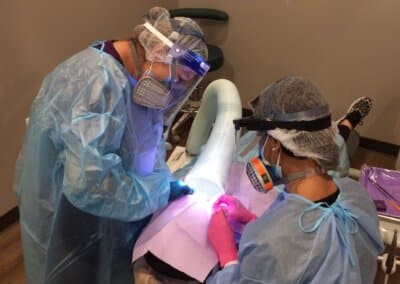Amalgam Fillings: Pros/Cons, How to Remove & Alternatives
What are amalgam fillings?
Amalgam fillings are made up of various metals and used to fill cavities, especially in your back teeth. Typical amalgam fillings consist of about 50% elemental mercury by weight. Fillings may be the worldwide number one source of mercury exposure to humans.
Mercury is used as filling material because:
- Mercury is cheap
- Mercury is durable
- Mercury easily forms to the shape of your tooth
Many experts, especially biological/holistic dentists, believe there is compelling scientific evidence that amalgam fillings are unsafe. These fillings, which contain mercury filling material, trigger adverse health effects, such as Alzheimer’s disease, multiple sclerosis, and heart disease.
Amalgam fillings are also known as:
- Dental amalgam fillings
- Silver amalgam fillings
- Silver fillings
- Mercury amalgam fillings
- Mercury fillings
What is an amalgam filling made of?
The dental amalgam metal that is in millions of Americans’ teeth contains a significant amount of mercury. You know, that poison stuff you aren’t supposed to touch or be around.
Mercury amalgam fillings (AKA silver fillings) are made up of the following materials:
- 50% mercury
- 35% silver
- 15% copper, nickel, tin, zinc, and other materials
Can mercury leak from amalgam fillings?
Yes, mercury can leak from amalgam fillings. Many in the medical community believe mercury released from amalgam fillings is not enough to contribute to mercury poisoning. I, Dr. George, and other biological/holistic dentists disagree.
Autopsies reveal that bodies with amalgam fillings contain 2 to 12 times the amount of mercury in their skin than bodies without amalgam fillings.
Bruxism (teeth grinding), a common problem for many dental patients, also increases the release of mercury vapors from amalgam fillings.
Are amalgam fillings still used?
Amalgam fillings are still used today. For 150 years, amalgam fillings have been used for dental health.
Despite WHO recommendations and many experts calling for the phasing out of mercury fillings, the majority of the medical community still considers amalgam restorations as the safest and most effective treatment option.
Benefits of Amalgam Fillings
- Cheap
- Durable
- Discourages tooth decay
Risks of Amalgam Fillings
The risks of amalgam fillings are well documented and dangerous. Mercury fillings make patients vulnerable to mercury’s harmful side effects.
Scientific studies have shown that mercury exposure is linked to the development or worsening of the following medical conditions:
- Alzheimer’s disease
- Amyotrophic lateral sclerosis (AKA Lou Gehrig’s disease)
- Antibiotic resistance
- Anxiety
- Autism spectrum disorders
- Autoimmune disorders/immunodeficiency
- Cardiovascular health problems
- Chronic fatigue syndrome
- Depression
- Fever
- Hallucinations
- Headaches
- Hearing loss
- Insomnia
- Kidney disease
- Memory loss
- Multiple sclerosis
- Oral lichenoid reaction, oral lichen planus
- Parkinson’s disease
- Periodontitis (AKA gum disease and gingivitis)
- Reproductive dysfunction
- Suicidal thoughts
- Chronic mercury poisoning
- Thyroiditis
- Tremors
- Death
Are amalgam fillings bad for you? Yes, amalgam fillings are bad for you. Amalgam fillings expose you to small amounts of mercury. The symptoms of mercury exposure are dangerous.
To Remove or Not to Remove Amalgam Fillings?
Should I remove my mercury fillings? We would test your blood mercury levels to determine if you are better off removing or keeping your mercury fillings.
If you have a history of bruxism (teeth grinding), your exposure is probably much higher than non-bruxers, so these cases require additional consideration.
Your highest mercury exposure occurs at placement and removal.
- If your blood mercury levels are low, we don’t want to needlessly expose you to mercury vapors during the removal process.
- If your blood mercury levels are high, we want to remove that filling as soon as possible.
Here are 6 opinions on the dangers of mercury exposure and amalgam fillings from top health organizations:
- The American Dental Association (ADA) stated, “Dental amalgam is one of the safest and most affordable and durable materials available.” They later added that approximately 1% of the population experiences adverse effects of amalgam fillings.
- The Centers for Disease Control and Prevention (CDC) said that the effects of low levels of mercury vapors in humans are unknown.
- The United Nations Environmental Program (UNEP) reported that there is no safe limit when it comes to mercury exposure.
- The World Health Organization (WHO) said, “Exposure to mercury — even small amounts — may cause serious health problems…” particularly with pregnant women or new mothers’ breast milk.
- The Environmental Protection Agency (EPA) reported that the use of dental amalgam fillings is on the decline because alternative filling materials are performing increasingly well.
- The U.S. Food and Drug Administration (FDA) said that removing amalgam fillings results in unnecessary loss of tooth structure and exposure to mercury vapors.
The Best Way to Remove Amalgams: The SMART Method
The best way to remove mercury amalgam fillings is the SMART Method, which employs:
- A rubber dam tooth umbrella to shield your mouth
- Providing disposable covering for hair and skin
- Removing the fillings in chunks so vapors are not released
- Using ozonated water before and after mercury replacements
- A HEPA filter/high-volume vacuum above patients
- Office air purification systems
- An ionizer to remove any additional mercury particles in the air
- Rinsing with chlorella/activated charcoal to remove traces of mercury
- Oxygen supply to breathe through the nose
As a biological dentist, I have been thoroughly trained and educated on the safe removal of mercury fillings. I am SMART-certified by the IAOMT to safely remove mercury fillings.
We understand the toxicity of mercury and use a SMART protocol to protect our patients and staff from the toxic vapors when removing any metals in your mouth along with a detox evaluation.
We have an elaborate purifying setup that we will walk you through before any treatment.
If you want your mercury fillings safely removed, come to Sugarland, Texas and visit us! We employ the SMART method to safely remove mercury amalgam fillings. To set up an appointment, call us at (713) 489-3790, or click on the SCHEDULE APPOINTMENT button in the corner of any page on our website.
Safe Alternatives for Dental Fillings
There are several safe alternatives to amalgam fillings:
- Composite fillings (AKA composite resin)
- Gold fillings (AKA gold ionomer fillings)
- Porcelain fillings (AKA ceramic fillings)
Mercury-free fillings exist, even if they may cost slightly more at this time. These alternative fillings use dental materials with no mercury content.
The above types of fillings are more biocompatible and do not cause allergic reactions or other adverse health effects.
The WHO recommends the United States start to phase out amalgam fillings immediately.
As the government drags its feets on phasing out the use of amalgam, you as an informed patient can choose the best alternative and eliminate unnecessary health risks.
Sources
- Jirau-Colón, H., González-Parrilla, L., Martinez-Jiménez, J., Adam, W., & Jiménez-Velez, B. (2019). Rethinking the Dental Amalgam Dilemma: An Integrated Toxicological Approach. International journal of environmental research and public health, 16(6), 1036. Full text: https://www.ncbi.nlm.nih.gov/pmc/articles/PMC6466133/
- Mutter, J. (2011). Is dental amalgam safe for humans? The opinion of the scientific committee of the European Commission. Journal of Occupational Medicine and Toxicology, 6(1), 2. Full text: https://link.springer.com/article/10.1186/1745-6673-6-2
- Counter, S. A., & Buchanan, L. H. (2004). Mercury exposure in children: a review. Toxicology and applied pharmacology, 198(2), 209-230. Full text: http://citeseerx.ist.psu.edu/viewdoc/download?doi=10.1.1.589.7613&rep=rep1&type=pdf
- Geier, D. A., Kern, J. K., & Geier, M. R. (2009). A prospective study of prenatal mercury exposure from maternal dental amalgams and autism severity. Acta Neurobiol Exp, 69(2), 189-97. Abstract: https://pubmed.ncbi.nlm.nih.gov/19593333/
Are we a good fit for you?
- You want to save time and money over your lifetime to get optimal health
- Your goal is to be the healthiest version of yourself to feel the best
- You want the least amount of dental work possible



